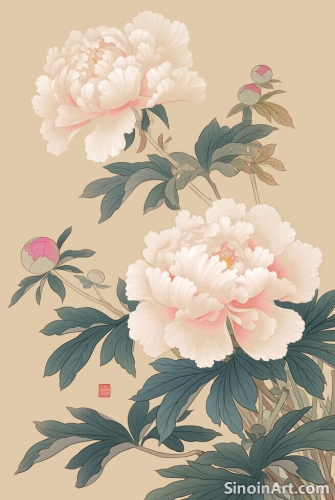Gongbi Painting and its Relationship to Calligraphy
|
Gongbi painting and Chinese calligraphy, while distinct art forms, share a deep and interconnected relationship. Both rely on the use of brushes, ink, and paper, and both place a strong emphasis on the quality and control of lines. This shared technical foundation and the common cultural heritage create a powerful link between these two traditional art forms.  The importance of line is paramount in both Gongbi painting and calligraphy. In Gongbi, the “gougou” outlining method relies on precise and controlled lines, similar to how calligraphers execute their strokes. The ability to vary line thickness, pressure, and direction is crucial for both art forms. The emphasis on controlled brushwork is a common skill that is essential for both disciplines.  The use of ink is another element that connects calligraphy and Gongbi painting. The quality of the ink, its density, and its application are important for both forms of expression. The preparation of ink, often involving grinding an inkstick on an inkstone, is a shared ritualistic process. Both artists rely on the understanding of the ink to achieve the desired effects.  The concept of qi, or vital energy, is central to both calligraphy and Gongbi. Both forms are considered to be not merely visual representations but also expressions of the artist's inner energy and spirit. The control of the brush, the flow of the ink, and the overall composition reflect the qi of the artist and creates a sense of dynamism and vitality within the work. The study of calligraphy is often considered an essential step in the training of a Gongbi artist. The discipline and skill in controlling brushwork that is developed through calligraphy practice directly translates to the painting process. Mastering the principles of calligraphy enhances the artistic expression in Gongbi. This training fosters both skill and appreciation for both art forms. The interplay between calligraphy and Gongbi painting extends beyond mere technical similarities. The shared cultural context and the underlying aesthetic principles create a powerful synergy. The practice of calligraphy helps to hone the aesthetic sensibilities necessary to appreciate both calligraphic works and the intricate details found in Gongbi. The connection between these forms is a testament to the depth and interconnected nature of Chinese art. |
Tag : Gongbi and calligraphy, Chinese calligraphy, brushwork in calligraphy, ink in art, relationship between art forms
Related information
- The Influence of Taoism and Confucianism on Gongbi
- Gongbi and the Depiction of Water: Capturing the Flow and Spirit
- A Historical Journey: The Origins of Gongbi Painting
- The Use of Borders and Mountings in Gongbi Painting
- Gongbi and the Court: Patronage and Artistic Standards in Imperial China
This article explores the influence of Taoism and Confucianism on Gongbi painting, highlighting how these philosophical traditions have shaped the aesthetic values, themes, and overall approach to artistic creation in this meticulous art form.
This article explores the depiction of water in Gongbi painting, highlighting the techniques used to capture its flow and movement, the use of color to suggest its depth, symbolic significance, and how it enhances the overall sense of harmony and balance within the artwork.
This article traces the historical development of Gongbi painting from its early origins to its modern resurgence, highlighting its evolution across dynasties and its place in Chinese art history.
This article explores the role of borders and mountings in Gongbi painting, highlighting their function as framing devices, visual balancers, and how their specific styles and materials contribute to the overall aesthetic and cultural significance of the artwork.
The history of Gongbi painting is intrinsically linked to the imperial courts of China, where it flourished under the patronage of emperors and the elite classes. The demand for highly detailed and realistic depictions of the natural world and court life led to the development of the meticulous techniques and refined aesthetic characteristic of the Gongbi tradition. This patronage significantly shaped the evolution and preservation of this distinctive style.